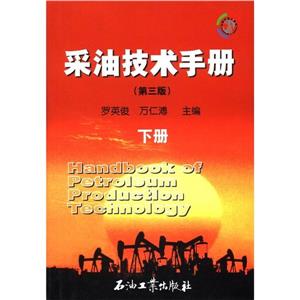
作者:编者:高长虹
页数:244
出版社:科学出版社
出版日期:2018
ISBN:9787030572103
电子书格式:pdf/epub/txt
内容简介
本书介绍了采油技术的整个工业流程,包括油气和岩石物性、油藏采收率原理、完井工艺、油气流入动态、管流特点和计算、人工举升、酸化压裂、防砂技术、采油技术难题、以及油气分离的原理和设计,读者可以通过本书,掌握从油藏到井筒,再到地面的采油关键技术,是目前很完整很核心的采油技术参考书。
作者简介
Changhong Gao received his degrees in petroleum engineering from China University of Petroleum, University of Tulsa and Curtin University. He worked for Sinopec as a field engineer and research engineer. He also taught at United Arab Emirates University, University of Aberdeen and Petroleum Institute of Abu Dhabi.
In 2013, he was elected Taishan Scholar by Shandong province government, as well as Yellow River Delta Scholar by Dongying city government. His teaching and research interests include drilling mud, production system design and enhanced oil recovery. He has published more than 30 journal papers and presented a few papers at SPE and APPEA conferences.
If you hope to contact the author, please email him at: 237184689@qq.com
目录
Chapter 1 Properties of Oil and Gas
1.1 Phase behavior
1.2 Properties of natural gas
1.2.1 Gas equation of state
1.2.2 Gas compressibility
1.2.3 Gas formation volume factor
1.2.4 Gas viscosity
1.3 Properties of crude oil
1.3.1 Oil density
1.3.2 Solution gas oil ratio
1.3.3 Oil formation volume factor
1.3.4 Oil viscosity
1.4 Fluid sampling
Chapter 2 Properties of Reservoir Rock
2.1 Basic petroleum geology
2.2 Porosity
2.3 Absolute permeability
2.4 Fluid Saturation
2.5 Surface tension and interracial tension
2.6 Wettability
2.7 Capillary action
2.8 Capillary pressure
2.9 Relative permeability
2.10 Electrical conductivity
2.11 Rock sampling
Chapter 3 Reservoir Recovery Mechanisms
3.1 Field life cycle
3.2 Primary recovery mechanisms
3.2.1 Rock and liquid expansion drive
3.2.2 Solution gas drive
3.2.3 Gas cap drive
3.2.4 Aquifer drive
3.2.5 Combination drive
3.3 Secondary recovery methods
3.4 Enhanced oil recovery
3.4.1 Thermal methods
3.4.2 Miscible gas flood
3.4.3 Chemical methods
Chapter 4 Fluid Flow in Reservoir
4.1 Basic concepts
4.2 Basic diffusivity equation
4.3 Linear flow under steady state
4.3.1 Steady-state linear flow of incompressible fluid
4.3.2 Steady-state linear flow of slightly compressible fluid
4.3.3 Steady-state linear flow of compressible gases
4.4 Radial flow under steady state
4.4.1 Steady-state radial flow of incompressible fluid under
4.4.2 Steady-state radial flow of compressible gases
4.5 Fluid flow under pseudo-steady state
Chapter 5 Drilling and Production Facilities
5.1 Drilling rigs
5.2 Drilling systems
5.2.1 Rotary drive and top drive
5.2.2 Drill string
5.2.3 Mud circulation
5.2.4 Blowout preventer
5.2.5 Casing program
5.3 Offshore production structures
Chapter 6 Well Completion
6.1 Lower completion
6.1.1 Open-hole completion
6.1.2 Cased-hole completion
6.1.3 Choice of lower completion
6.1.4 Cementing a cased well
6.1.5 Perforating a cased well
6.2 Upper completion
6.2.1 Options for upper completion
6.2.2 Christmas tree and tubing hanger
6.2.3 Safety valve
6.2.4 Production packer
6.2.5 Smart completion
Chapter 7 Well Inflow Performance
7.1 Well productivity index
7.2 Vogel IPR
7.3 Fetkovich IPR
7.4 Productivity of Horizontal Wells
Chapter 8 Fluid Flow in Wells and Nodal Analysis
8.1 Single-phase flow in pipes
8.2 Multiphase flow concept
8.3 Multiphase flow models
8.4 Tubing performance relationship
8.5 Nodal analysis for production system
Chapter 9 Artificial Lift Methods
9.1 Sucker rod pump
9.2 Gas lift
9.2.1 Gas lift system
9.2.2 Well unloading and kick-off
9.3 Electrical submersible pump
9.4 Other artificial lift methods
9.5 Discussions
Chapter 10 Acidizing and Fracturing
10.1 Formation damage and skin factor
10.2 Fracturing
10.2.1 Fracture pressure
10.2.2 Fracturing fluid and proppants
10.2.3 Models of fracture geometry
10.3 Matrix acidizing
Chapter 11 Sand Control
11.1 Grain size distribution
11.2 Gravel pack
11.3 Screens
11.3.1 Wire-wrapped screens
11.3.2 Premium screens
11.3.3 Pre-packed screens
11.3.4 Expandable screens
Chapter 12 Flow Assurance
12.1 Scale
12.2 Waxes
12.3 Asphaltenes
12.4 Hydrates
12.4.1 Types of hydrates
12.4.2 Hydrate prevention
12.4.3 Removal of hydrate plug
Chapter 13 Separation and Treatment
13.1 Separator configurations
13.2 Theories of separation
13.2.1 Terminal velocity
13.2.2 Gas capacity constraint
13.2.3 Retention time requirement
13.2.4 Oil pad thickness
13.2.5 Water phase thickness
13.2.6 Slenderness ratio
13.3 Separator sizing
13.4 Gas treatment
13.4.1 Gas dehydration
13.4.2 Gas compression
13.4.3 Downstream gas processing
13.5 Oil dehydration
13.6 Water treatment
Main References
Appendix A















